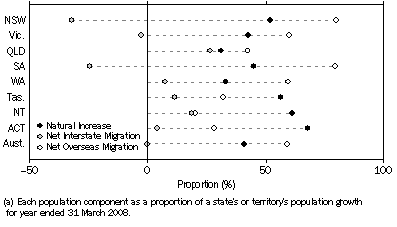MAIN FEATURES
POPULATION AND GROWTH
The preliminary estimated resident population (ERP) of Australia at 31 March 2008 was 21,283,000 persons, an increase of 336,800 since 31 March 2007 and 102,000 persons since 31 December 2007. The increase for the year ended 31 March 2008 is the largest recorded for a 12 month period since the ERP concept was introduced in 1971 (see paragraphs 4 to 6 of the Explanatory Notes for more detail).
The annual population growth rate for the year ended 31 March 2008, at 1.61% was the fastest annual growth rate for a year ended 31 March since 1989 (at 1.78%).
COMPONENTS OF POPULATION CHANGE
The growth of Australia's population has two components: natural increase (the number of births minus the number of deaths) and net overseas migration.
Natural Increase
Natural increase for the 12 months ended 31 March 2008 was 137,700 persons, a decrease of 0.7% (or 940 persons) on the natural increase for the year ended 31 March 2007 (138,600 persons).
BIRTHS
The preliminary estimate for births during the year ended 31 March 2008 (278,200) was 1.5% higher than the figure for the year ended 31 March 2007 (274,100).
DEATHS
The preliminary estimate for deaths during the year ended 31 March 2008 (140,500) was the highest ever recorded for a year ending 31 March.
Net Overseas Migration
For the year ended 31 March 2008, Australia recorded a preliminary net overseas migration (NOM) estimate of 199,100 persons. This was the difference between 429,300 overseas arrivals that were added to the population (NOM arrivals) and 230,300 overseas departures that were subtracted from the population (NOM departures). The contribution made to population growth by NOM (59.1%) was higher than that of natural increase (40.9%).
AN IMPROVED METHOD FOR CALCULATING NET OVERSEAS MIGRATION
The ABS has introduced an improved method for estimating NOM. This method has been used for September quarter 2006 onwards. Preliminary NOM estimates are based on international movement data for the reference quarter, adjusted by information derived from travellers with the same characteristics from the corresponding quarter two years earlier. Final NOM estimates for the four quarters of 2006-07 (scheduled for release in March 2009) will be based on the actual duration of stay in Australia and overseas of international travellers.
The time series using the previous method for calculating NOM finishes at June quarter 2006. Estimates from this past time series and the current time series are not comparable. For further information see Information Paper: Improved Methods for Estimating Net Overseas Migration (cat. no. 3107.0.55.003); Information Paper: Statistical Implications of Improved Methods for Estimating Net Overseas Migration, Australia 2007 (cat. no. 3107.0.55.005); and the Technical Note Measuring Net Overseas Migration, Method Used September Quarter 2001 to June Quarter 2006 in the March quarter 2007 issue of this publication (cat. no. 3101.0).
STATES AND TERRITORIES: POPULATION AND GROWTH
The estimated resident populations for the states and territories at 31 March 2008 were as follows: New South Wales 6,947,000, Victoria 5,274,000, Queensland 4,253,000, South Australia 1,598,000, Western Australia 2,149,000, Tasmania 497,300, the Northern Territory 218,400 and the Australian Capital Territory 342,700.
All states and territories recorded positive population growth over the 12 months ended 31 March 2008. Western Australia recorded the fastest growth rate (2.6%), followed by Queensland and the Northern Territory (2.2%), Victoria (1.7%), the Australian Capital Territory (1.4%), New South Wales and South Australia (1.1%) and Tasmania (0.9%).
COMPONENTS OF POPULATION CHANGE
At the state and territory level, population growth has three components: natural increase, net overseas migration and net interstate migration.
Although all states and territories experienced positive population growth in the year ended 31 March 2008, the proportion that each of these components contributed to population growth varied between the states and territories.
Population Components as proportion of total growth(a) - Year ended 31 March 2008

Natural Increase
As illustrated in the graph above, natural increase was a major component of population growth in the Australian Capital Territory at 67.8% (3,100 persons), the Northern Territory at 61.2% (2,800 persons), Tasmania at 56.3% (2,600 persons) and New South Wales at 52.1% (37,700 persons) for the year ended 31 March 2008.
BIRTHS
The number of births registered for the 12 months ended 31 March 2008 increased in comparison with the previous year, in all states and territories except New South Wales and Queensland. For New South Wales, the processing of birth registrations has been delayed in March quarter 2008 and priority given to death registrations (see Table 13). Victoria recorded the largest percentage increase of 9.2%, closely followed by South Australia with 8.2%.
DEATHS
The number of deaths registered for the 12 months ended 31 March 2008 increased in comparison with the previous year, in all states and territories. Queensland recorded the largest percentage increase of 10.2% closely followed by the Northern Territory with 9.8%.
Net Overseas Migration
Net overseas migration for the year ended 31 March 2008, as illustrated in the previous graph, was a major component of population growth in New South Wales at 80.0% (58,000 persons), closely followed by South Australia at 79.3% (13,400 persons). This was followed by Victoria at 60.1% (52,700 persons) and Western Australia at 59.6% (32,300 persons). All other states and territories experienced positive net overseas migration.
Net Interstate Migration
For the year ended 31 March 2008, Queensland experienced the highest positive net interstate migration with a gain of 24,300 persons. Other states and territories that experienced positive net interstate migration were Western Australia (4,000 persons), the Northern Territory (850 persons), Tasmania (520 persons) and the Australian Capital Territory (190 persons). Negative net interstate migration was experienced by New South Wales (23,300 persons), South Australia (4,100 persons) and Victoria (2,400 persons).
Interstate migration, Arrivals, Departures and Net
- States and territories
- Year ended 31 March 2008

 Print Page
Print Page
 Print All
Print All
 Quality Declaration
Quality Declaration